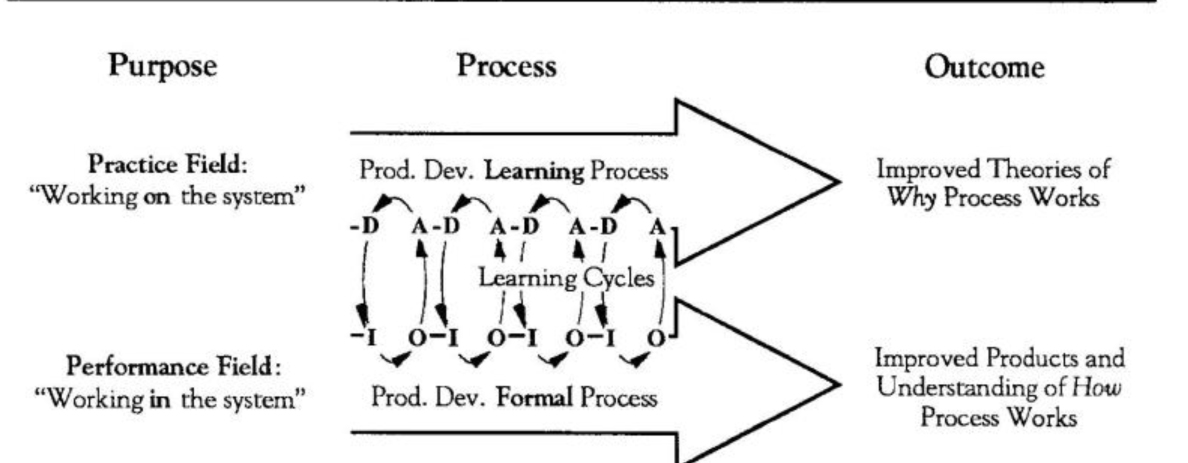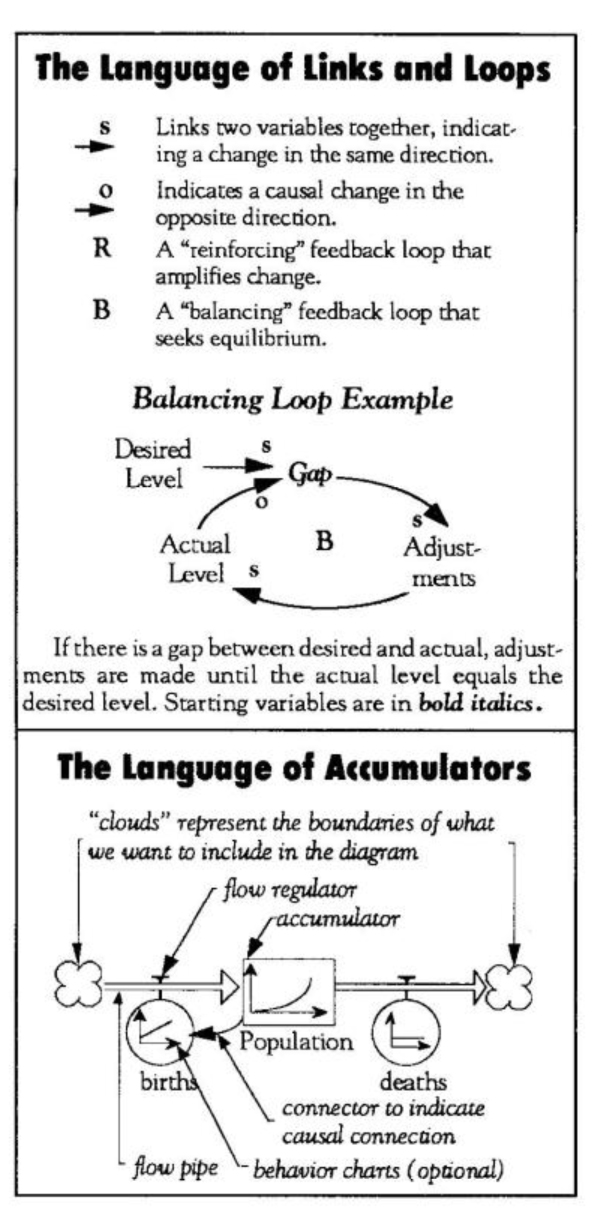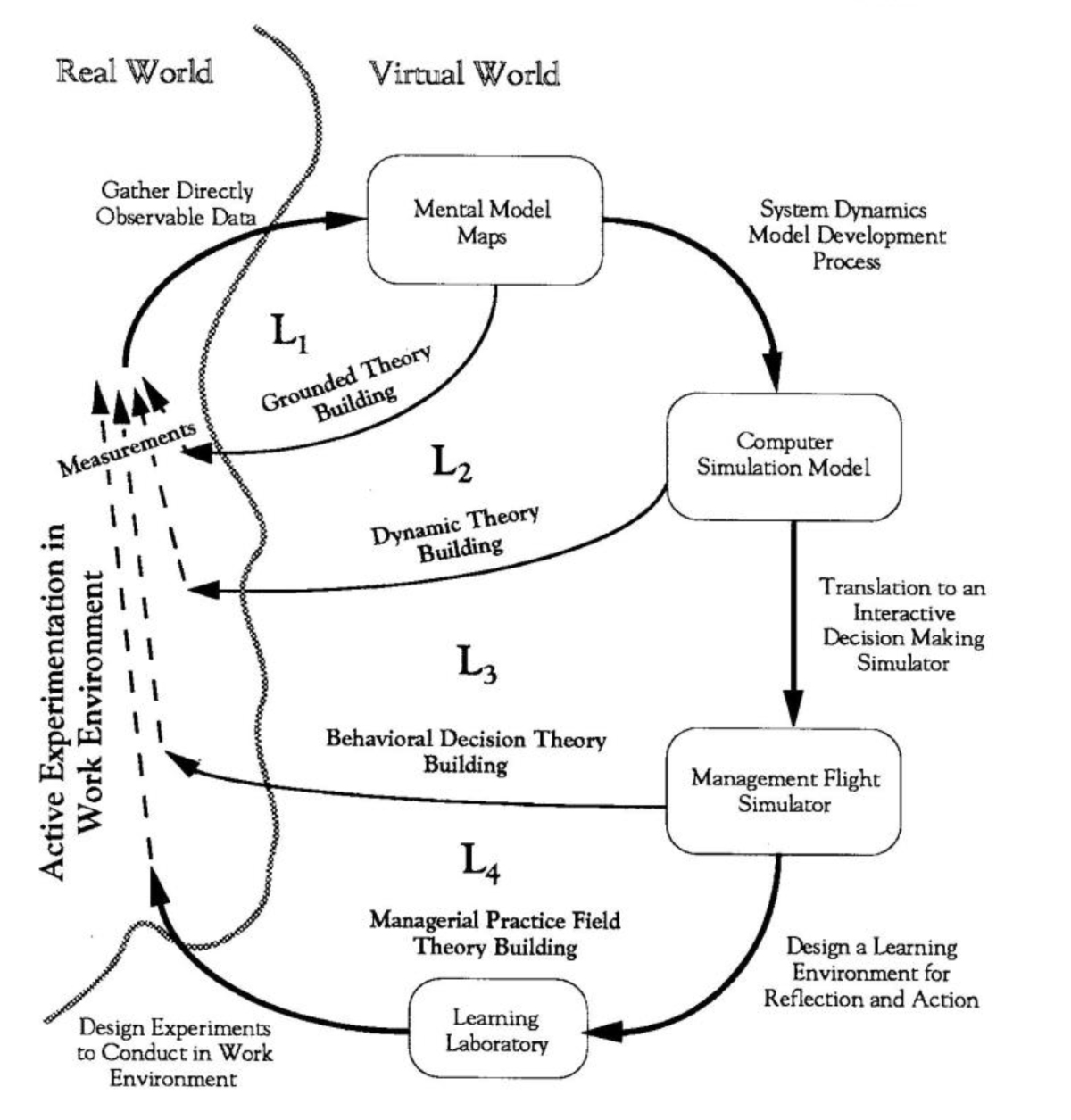In order to facilitate and accelerate learning, we need to design opportunities for making mistakes. While organizations have many fail-safe systems to ensure smooth operations, most companies have few “safe-failing” spaces to enhance learning.
Learning infrastructures create a process through which the assumptions of an organization are continually surfaced, challenged, and (if necessary) changed. Such structures are places in which corporate sacred cows are subject to scrutiny rather than accepted as truth, and where multiple future scenarios are developed and explored rather than focusing on a single” plan.
Parallel Learning Process

The O-A-D-I (Observe-Assess-Design-Implement) learning cycle links the practice and performance fields together in a continuous process of theory building and experimentation.
For most organizations, such learning infrastructures do not exist. Yet they may be the single most important factor for creating sustained competitive advantage because they can provide an organization with the ability to continuously learn about itself. Learning infrastructures provide the means for an organization to develop its own theory (or set of principles) of how it works in a way that is comprehensible and actionable to its members.
An Infrastructure for Working “on” the System
Building infrastructures for learning requires a parallel process that takes us out of the day-to-day pressures into a different kind of space in which we can practice and learn. With learning infrastructures, we are able to step out of the system so that we can work “on” it and not just “in” it. There is an ongoing learning cycle that creates a bridge between the performance field (working in the system) and practice fields (working on the system) (see “Parallel Learning Process” for example of this learning cycle applied to product development process). The learning cycle of Observe-Assess-Design-Implement (O-A-D-I) links the two processes together: “Assess” and “Design” are more emphasized in the practice field and “Implement” and “Observe” are more emphasized in the performance field.
Perhaps the most important link in the learning cycle lies in the “Observe-Assess” step, because our designs can only be as good as the assessments on which they are based. In turn, if our assessments are not grounded in actual observations, but in previously-held assessments, then we are on shaky ground. The 0-A-D-I learning cycle thus helps us continually reflect on what we think we know and how we know it — in essence, to challenge our prevailing mental models.
This parallel process can be likened to a manager’s equivalent of a practice field, which enhances his or her ability to perform online by creating an environment that is safe for experimentation and failures. Like a sports team, the practice field provides the tools and the appropriate arena for trying out new “plays” or strategies that may be a radical departure from standard procedure.
A management flight simulator, for example, can be most useful for understanding situations in which causality is distant in time and space, or when the inherent time lag is particularly long (on the order of months or years) and organizational complexity is high (see “Management Flight Simulators: Flight Training for Managers,” Parts I and II, Nov. 1992 and Dec. 1992/Jan. 1993). Management flight simulators are one of many tools that can be used in a practice field. Causal loop diagrams, systems archetypes, action maps, dialogue, and the Ladder of Inference are among the many other tools and frameworks that can also be utilized to enhance learning.

Creating learning infrastructures such as practice fields or learning laboratories is an important part of becoming a learning organization, but alone it is inadequate. It is too easy for such structures to become “training” infrastructures. There is nothing wrong with training per se. But training involves teaching a new twist on a well-established body of knowledge or disseminating that body of knowledge itself. Learning, on the other hand, requires a shift in the understanding of the base of knowledge itself. It is the difference between acquiring new information that fits into a current theory and developing a new theory. Learning infrastructures should help organizations build their own ongoing theories about how they work as a system.
Theory-Building Process
Because individuals are continually learning in organizations, one can argue that organizations are very supportive of learning. In most cases, however, the learning is done at an individual, not organizational, level. Oftentimes, there is no coherent process for integrating the learnings of many individuals into a form that can benefit the whole organization. In short, there is no theory-building process.
The word theory is too often viewed as an esoteric word that has no practical meaning. In fact, theory is of utmost practical importance because theories are distillations of our knowledge and understanding of the world. Theories represent the general principles drawn from a body of facts and observations. Without them, we could not learn because we would have no means to provide a coherent structure to our observations.
Given today’s pace of change and organizational complexity, managers need to be competent in applying the research skills of a scientist to better develop theories about how their organizations work as a system. The old paradigm of feeding experiments from organizations into research institutions that then feed the results back is no longer adequate.
In Beyond the Stable State, Donald Schon points out that a major disruption in this paradigm occurred when the pace of change crossed into the intra-generational state — when lessons learned became obsolete within the same generation. Given this pact of change, the research cycle must be compressed, otherwise solutions (in the form of research results) will be stillborn — the problems that they addressed will no longer be relevant.
Managers’ New Roles: Researcher and Theory-Builder
In order to keep pace with intra-generational change, managers need to become theory-builders within their own organizations. It is no longer sufficient to apply generic theories and frame-works like Band-Aids to one’s own specific issues. As theory-builders, managers must have an intimate knowledge of how their organization works as a whole — but they also require some guiding theory and methodology to make sense of their experience and learning.
There is no “golden formula” that will hold for all time. Companies that lived by the learning curve theory almost died by it (as in the case of Texas Instruments and the personal computer debacle). Others who followed the BCG business portfolio theory also had their share of problems. Theory building should therefore not be done as an academic exercise but as a process grounded in reality that continually helps provide a framework for interpreting one’s competitive environment.
Theory-Building loops
There are several projects being conducted at the MIT Organizational Learning Center which attempt to design and embed a theory-building process within an organization. By conducting parallel “experiments” at multiple company sites, we hope to accumulate learnings across organizations that will allow each individual organization to accelerate its own learning. We are trying to integrate a variety of research methods that build theory at various levels (see “Organizational Theory-Building Cycle”). Although a lot of the Learning Center work lies in the (virtual) world of ideas, model formulation, and design of flight simulators and learning labs, an important aspect of the Learning Center’s theory-building process is its close integration with active experimentation in several company sites.
The Learning Center research efforts can be viewed in terms of four interrelated learning loops which guide all projects — grounded theory building, dynamic theory building, behavioral decision theory building, and managerial practice field theory building:
Grounded Theory Building (Loop L1): This loop represents the field research tradition of building theory based on observable data. It is rooted in direct observations, but instead of bringing pre-formulated frameworks that are then applied to the data, we try to hear what the facts themselves have to say.
Grounded theory building is an inductive process of suspending prior assumptions in order to view observable data through fresh eyes. Action science, clinical research, and ethnography are probably the most relevant research approaches. Mapping tools such as systems archetypes, causal loop diagrams, and action maps can play an important role in building grounded theory.
Dynamic Theory Building (Loop L2): Static models can provide illuminating frameworks to better understand our observations (e.g., supply and demand curves of economics), but they don’t provide an opportunity to explore the rich set of dynamics that are possible over time. In dynamic theory building, we are interested in understanding how our grounded theories play out over time. This loop includes the traditional system dynamics model-building process of data collection, model formulation, testing, revising, and validation. It includes some of the work represented by loop L1, but builds on it in a more rigorous fashion.
Behavioral Decision Theory Building (Loop L3): People do not always behave rationally or in their best interests, especially in complex dynamic environments where causality is separated in space and time. This theory loop attempts to understand why people make the decisions they do in order to improve their decision making in the future. MIT Professor John Sterman’s work on dynamic decision making is a good representation of behavioral decision theory studies. Using interactive computer simulators to study how managers make decisions in a laboratory setting is one part of the work; linking the impact of those studies to actions in the workplace is another.
Managerial Practice Field Theory Building (Loop L4): Creating meaningful practice fields for managers requires an understanding of what makes a practice field “real” enough to be taken seriously and yet “playful” enough to provide a learning environment.
Experiments can be conducted in the practice field that would not be possible in the actual work environment, and successive rounds of experiments can help an organization begin to develop its own organizational theory.
All four learning loops are important to organizational theory building. In the short term, no single project is likely to adequately address all four loops at once. But over time, the collection of various projects across many companies will help us build a rich set of theories about how organizations learn at multiple levels. The hope is that as more organizations engage in theory building, it will become such an embedded part of doing business that the alternation between practice and performance will be a seamless process of integrated learning.
Organizational Theory-Building Cycle

The four theory-budding loops integrate a variety of research methods to build theory at various levels.
